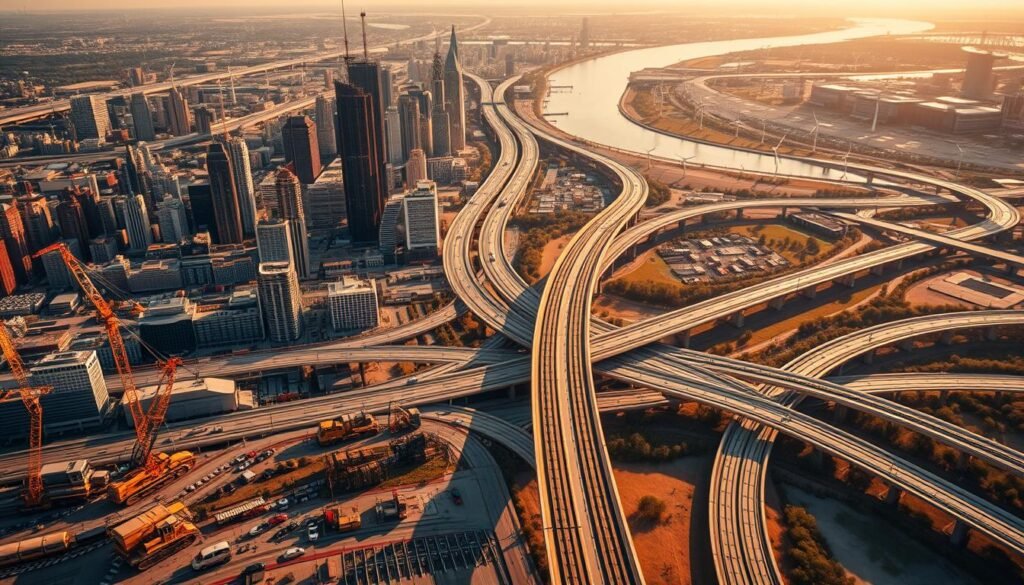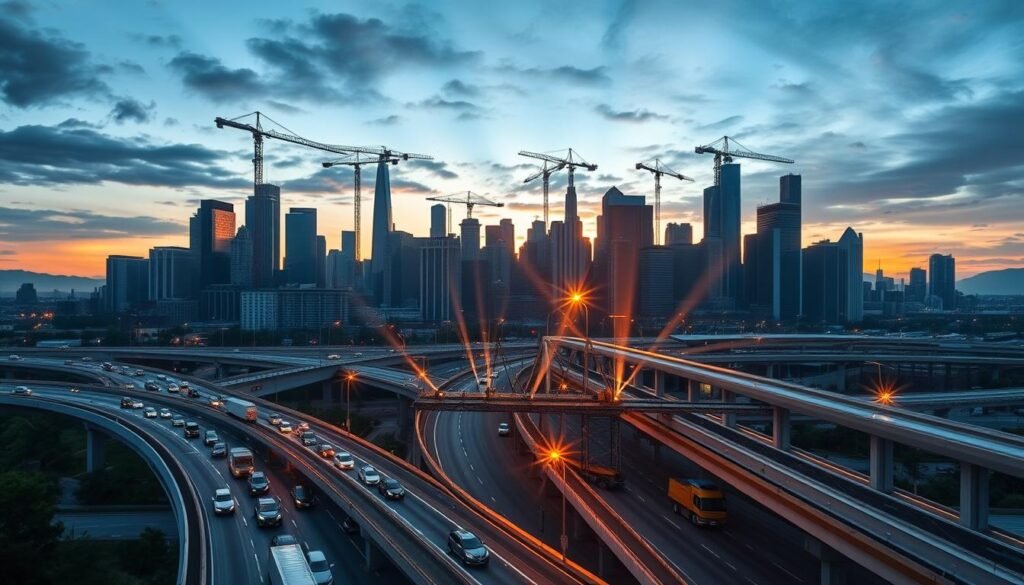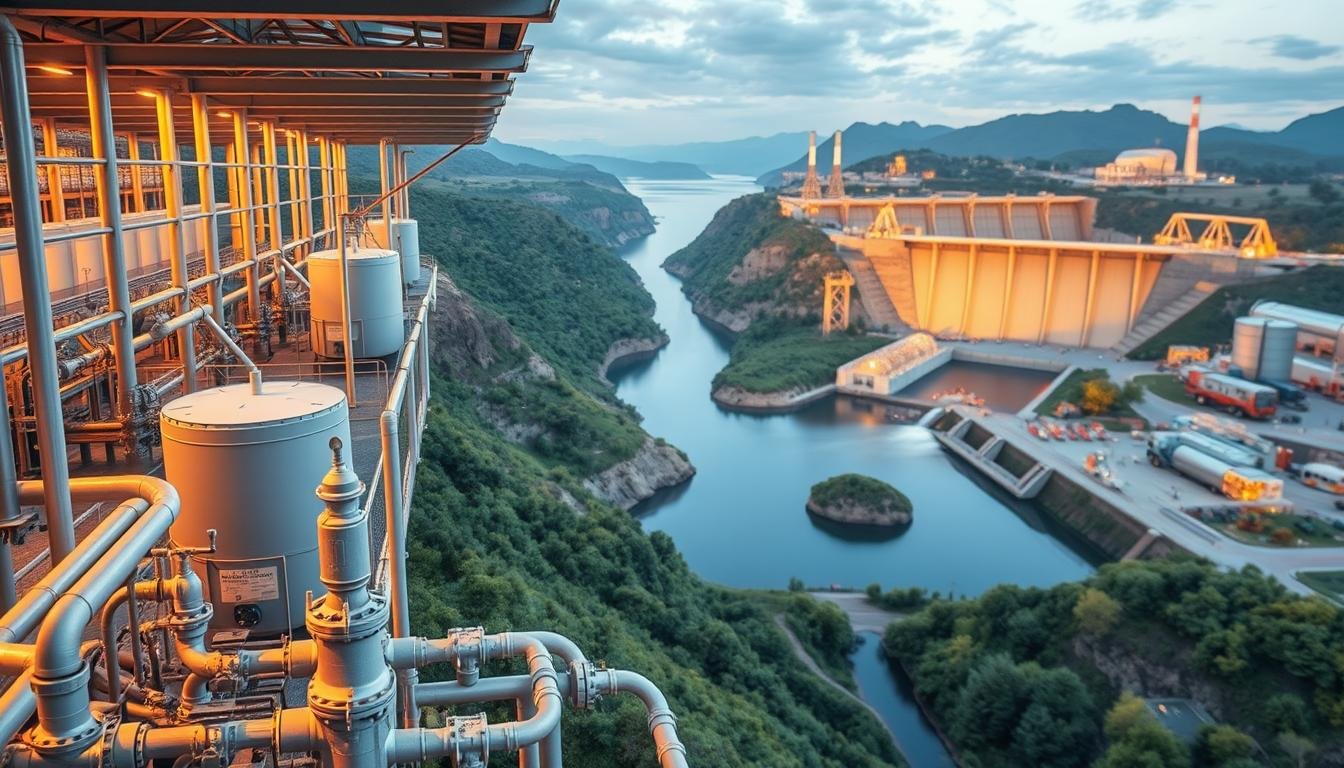The United States is starting a big journey to improve its infrastructure. It wants to make it more sustainable, efficient, and modern. This will involve making the transportation network better, which is key for the country’s growth.
The government is also working on digital infrastructure. This is important for America’s future. With these plans, the U.S. aims to lead in modern and sustainable infrastructure. This will help the economy grow and make life better for everyone.

Key Takeaways
- The U.S. government is investing in U.S. infrastructure development plans to create a more sustainable and efficient system.
- Transportation network modernization is a key aspect of the infrastructure overhaul, aiming to drive economic growth and development.
- Digital infrastructure enhancement is a crucial component of the government’s plans, focusing on creating a modern and connected nation.
- The infrastructure plans will improve the quality of life for U.S. citizens, making it an attractive place to live and work.
- The U.S. infrastructure development plans will have a positive impact on the country’s economy, creating new job opportunities and stimulating growth.
- The government’s focus on digital infrastructure enhancement will enable the U.S. to become a leader in technology and innovation.
Understanding America’s Infrastructure Challenge
The United States is facing a big infrastructure challenge. It affects the economy, public health, and safety. Reports show we need to fix critical areas like transportation, energy, and water systems right away.
Some key areas that need fixing include:
- Transportation networks, including roads, bridges, and public transit systems
- Energy systems, including power plants, transmission lines, and distribution networks
- Water systems, including drinking water treatment plants, wastewater treatment plants, and stormwater management systems
The economic impact of bad infrastructure is huge. It can cost the economy billions each year. Bad infrastructure can also harm public health and safety, like dirty water and bridge collapses.
It’s important to understand the infrastructure challenge to make good plans. We need to find critical areas to fix first and figure out how to deal with the economic impact. This way, the U.S. can keep its infrastructure strong for its people and economy, and keep everyone safe and healthy.
The Biden Administration’s U.S. Infrastructure Development Plans
The Biden administration has big plans for U.S. infrastructure. They want to create jobs, improve health and safety, and make the country more competitive. Their infrastructure development plans include investments in transportation, digital infrastructure, and clean energy. These plans will shape the future of U.S. infrastructure.
Key elements of the Biden administration’s plans include:
- Investing in transportation infrastructure, such as roads, bridges, and public transit
- Enhancing digital infrastructure, including broadband internet and 5G networks
- Developing clean energy sources, such as wind and solar power
The Biden administration’s infrastructure development plans aim to create a more sustainable and competitive economy. They will use a mix of federal funding and private sector investment. As the U.S. grows, these plans will be key to its future.
The Biden administration is dedicated to creating jobs and improving health and safety. They plan to invest in transportation, digital infrastructure, and clean energy. This will help make the U.S. economy more sustainable and competitive. As the U.S. continues to evolve, these plans will be crucial for its future.
Transportation Network Modernization
The United States is growing, and its transportation network is key to connecting everyone and everything. Modernizing this network is crucial for better efficiency and safety. This means investing in highway reconstruction to cut down on traffic and make travel smoother.
Public transit enhancement is also a big part of this effort. Upgrading public transport helps the U.S. offer reliable, green, and efficient travel options. This benefits people, the economy, and the environment. Some key advantages include:
- Reduced traffic congestion
- Improved air quality
- Increased economic growth
- Enhanced quality of life
Studies show that modernizing transportation can boost the economy. Better transport systems mean less money lost to traffic jams, accidents, and upkeep. This leads to more jobs, economic growth, and a better life for everyone.
In summary, modernizing the U.S. transportation network is vital. By focusing on highways and public transit, the country can make travel safer, more efficient, and greener. This benefits everyone, the economy, and the planet.
Digital Infrastructure Enhancement
Investing in digital infrastructure is key for the U.S. to stay ahead globally. It’s about broadband expansion to get fast internet everywhere, especially in rural areas. This move will boost public services, open new business and personal chances, and close the digital gap.
Some main areas to focus on for digital upgrade include:
- Building smart cities with modern tech and better public services
- Getting fast internet to rural and less connected places
- Updating digital systems to handle new tech like 5G and IoT
Recent studies show digital upgrade is vital for the U.S. economy’s future. By focusing on digital infrastructure enhancement and broadband expansion, the U.S. can find new ways to grow, innovate, and stay competitive.
In short, investing in digital upgrade is crucial for the U.S. to lead globally. By working on broadband expansion and other digital areas, the U.S. aims for a more connected, efficient, and prosperous society for everyone.
Clean Energy Initiatives
The United States is working hard to cut down its carbon footprint. It’s moving towards clean energy initiatives for a greener future. The country is putting a lot of money into renewable energy projects to make this happen.
By using more solar and wind power, the U.S. can use less fossil fuels. This will help lower greenhouse gas emissions.
Another big focus is on electric vehicle infrastructure. The goal is to set up more charging stations everywhere. This makes it easier for people to drive electric cars.
With more electric cars, the need for fossil fuels will go down. This means less air pollution and less harm to the climate.
- Job creation in the renewable energy sector
- Reduced greenhouse gas emissions
- Improved air quality
- Enhanced energy security
By investing in renewable energy projects and electric vehicle infrastructure, the U.S. can build a better future. It will help the environment and create new jobs. This will also boost the economy.
Water Infrastructure Improvements
Improving water infrastructure is key for the health and safety of Americans. By creating better water management systems, the U.S. can lower the risk of waterborne diseases. This also improves the quality of drinking water.
This is vital in places where the current systems are old or not good enough.
Some important areas for water infrastructure improvements include:
- Upgrading water treatment plants to handle more water and improve quality
- Replacing old pipes to cut down on leaks and contamination
- Using more efficient water management systems to save water and reduce waste

By investing in water infrastructure improvements and better water management systems, the U.S. can ensure a safe and sustainable water supply for the future.
Urban Development and Smart Cities
The United States is growing rapidly, leading to a big need for better urban planning. Smart cities are seen as a way to tackle issues like infrastructure, transportation, and being green. Projects are underway to make cities better places to live, improving life for everyone.
Improving metropolitan areas is a big part of this effort. It includes making transportation systems better and enhancing public services. Using technology, like data analytics, is also key. This helps cities meet their citizens’ needs, making them more appealing and competitive.
- Energy-efficient buildings and infrastructure
- Smart transportation systems, such as intelligent traffic management and public transit
- Advanced waste management and recycling systems
- Green spaces and urban parks
These features make cities better for living and help them grow economically. By focusing on urban development and smart cities, the U.S. can build more sustainable and efficient cities. These cities will attract businesses, talent, and investment.
Rural Infrastructure Development
Rural infrastructure development is key to closing the gap between cities and rural areas in the U.S. It includes rural broadband expansion. This is crucial for giving rural areas fast internet. It boosts their economic chances and improves their quality of life.
Important parts of rural infrastructure development are:
- Improving transportation networks, such as roads and highways
- Enhancing access to essential services, such as healthcare and education
- Expanding rural broadband expansion to connect rural communities to the digital world
Investing in rural infrastructure helps the U.S. become more equal. Reports show that rural projects have a big positive effect on local economies and communities.
In summary, rural infrastructure development, including broadband, is essential for rural growth and prosperity in the U.S.
Infrastructure Funding and Investment
Getting enough money for infrastructure is key to the U.S. plans. The federal government is a big help, giving a lot of money for projects. This money goes to things like roads, digital systems, and energy.
States also chip in, adding to the federal funds. This helps meet local needs. Plus, working with the private sector can bring in more money and skills. This partnership can make projects happen faster and cheaper, and better quality.
Some important parts of getting money for infrastructure include:
- Federal funding allocation: Giving money for projects through federal grants.
- State-level contributions: Adding to federal funds with state and local money.
- Private sector partnerships: Working with companies to bring in money, skills, and new ideas.
By using all these ways to get money, the U.S. can fund its infrastructure plans well. This will help the economy grow, create jobs, and make life better for everyone.

Job Creation and Economic Benefits
Infrastructure development is a major driver of job creation and economic benefits in the United States. Investing in infrastructure creates new jobs, boosts economic growth, and makes the country more competitive. Reports show that every dollar spent on infrastructure can bring in up to three dollars in returns, making it a wise investment for the future.
The benefits of infrastructure development are vast. It increases productivity, improves transportation, and enhances quality of life. It also attracts new businesses, leading to more economic activity and jobs. Key areas for impact include:
- Transportation networks, such as highways, bridges, and public transit systems
- Digital infrastructure, such as broadband networks and data centers
- Energy systems, such as renewable energy projects and grid modernization efforts
Infrastructure development also benefits the environment. Investing in green infrastructure, like parks and green roofs, reduces carbon emissions, improves air quality, and boosts residents’ quality of life.
In summary, infrastructure development is crucial for economic growth and job creation in the United States. By investing in infrastructure, the government can create jobs, stimulate growth, and boost competitiveness. As the country grows, prioritizing sustainable and environmentally friendly infrastructure development is essential.
Environmental Impact and Sustainability Measures
The United States is planning to develop its infrastructure. It’s important to think about how these projects will affect the environment. The aim is to reduce harm to nature while making the country more resilient to climate change.
Green infrastructure is key to this goal. It includes using natural systems in urban planning. For example, green roofs, urban forests, and wetlands can help fight climate change. They do this by reducing stormwater runoff and improving air quality.
Climate resilience planning is also vital. It helps identify and prepare for climate change impacts on infrastructure. By planning for climate change, the U.S. can protect its infrastructure and save money on disasters.
Some important strategies include:
- Reduced stormwater runoff and improved water quality
- Enhanced air quality and reduced urban heat island effect
- Increased energy efficiency and reduced greenhouse gas emissions
- Improved public health and well-being
In summary, taking care of the environment is crucial in infrastructure development. By using green infrastructure and planning for climate change, the U.S. can reduce its environmental impact. This will help create a sustainable future for all.
Conclusion: Building America’s Tomorrow
The Biden administration’s plans for U.S. infrastructure are a big step forward. They aim to make America’s future better by improving transportation, digital systems, and clean energy. This will make America more sustainable, efficient, and strong.
To make this vision real, we need to keep innovating, working together, and caring for the environment. The U.S. must plan for the needs of future generations in its infrastructure projects.
By working with partners, using funds wisely, and focusing on green tech, the U.S. can lead in infrastructure. This will create jobs, boost the economy, and improve life for everyone in America.
FAQ
What are the key elements of the Biden administration’s U.S. infrastructure development plans?
The Biden administration aims to create jobs and improve public health and safety. They also want to make the U.S. more competitive. Their plans include investments in transportation, digital infrastructure, and clean energy.
How will the transportation network modernization efforts impact the U.S.?
Modernizing the U.S. transportation network is key. The plans include fixing highways and bridges, improving public transit, and upgrading railways. These efforts will make travel safer and more efficient, boosting the economy and the environment.
What are the plans for digital infrastructure enhancement in the U.S.?
The U.S. needs to stay competitive globally. The plans include expanding broadband and building smart cities. These investments will improve internet access, public services, and business opportunities.
How are the clean energy initiatives outlined in the infrastructure plans?
The U.S. aims to cut carbon emissions and switch to clean energy. The plans include renewable energy projects, electric vehicle charging, and grid upgrades. These efforts will reduce fossil fuel use, create jobs, and help the environment.
What are the plans for water infrastructure improvements in the U.S.?
Improving water infrastructure is crucial for health and safety. The plans include better water management and upgrading existing systems. These investments will reduce waterborne disease risks, improve drinking water quality, and make water systems more resilient.
How will the infrastructure development plans impact urban areas and the creation of smart cities?
The U.S. is seeing fast urban growth. The plans include urban development and smart city initiatives. These focus on improving cities, integrating technology, and sustainability. Investing in cities will make them more livable and sustainable for everyone.
What are the plans for rural infrastructure development in the U.S.?
Rural areas need better infrastructure to bridge the urban-rural gap. The plans include broadband expansion, transportation upgrades, and access to services. These efforts will enhance rural life, create jobs, and reduce the urban-rural divide.
How will the infrastructure funding and investment be structured?
Securing funding is essential for infrastructure projects. The plans include federal, state, and private funding. With enough money, the U.S. can start projects, create jobs, and boost the economy.
What are the economic benefits of the infrastructure development plans?
Infrastructure development creates jobs and boosts the economy. The plans aim to start new industries, increase productivity, and improve competitiveness. This will bring significant economic benefits to the U.S.
How are the environmental impact and sustainability measures being addressed in the infrastructure plans?
The plans consider the environment and sustainability. They include green initiatives, climate resilience, and carbon reduction goals. By focusing on sustainability, the U.S. can reduce its environmental impact, adapt to climate change, and ensure a sustainable future.
